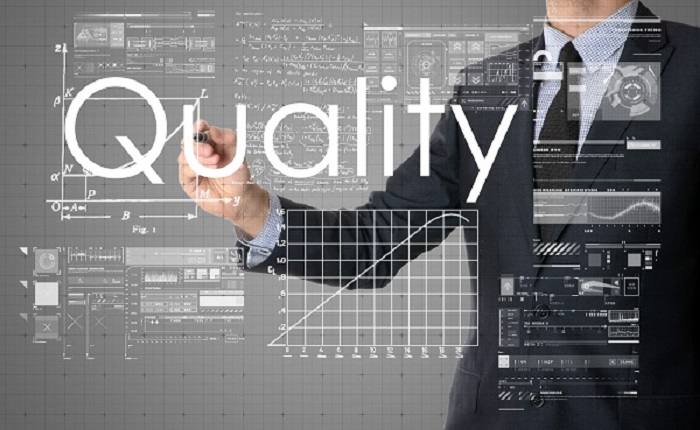
 Data Structure
Data Structure Networking
Networking RDBMS
RDBMS Operating System
Operating System Java
Java MS Excel
MS Excel iOS
iOS HTML
HTML CSS
CSS Android
Android Python
Python C Programming
C Programming C++
C++ C#
C# MongoDB
MongoDB MySQL
MySQL Javascript
Javascript PHP
PHP
- Selected Reading
- UPSC IAS Exams Notes
- Developer's Best Practices
- Questions and Answers
- Effective Resume Writing
- HR Interview Questions
- Computer Glossary
- Who is Who
Quality Management Strategy - PRINCE2® Approach
Quality is an important element of a project. Although cost and schedule are crucial parameters during the project, quality is the final thing that matters. Every project and organization has its own quality requirements. It is important for the project management principles to ensure that all the processes lead to the quality requirement of the client.
What Is Quality Management?
Quality Management is the systematic way of monitoring and delivering a project with the expected quality requirements. It sets standards, responsibilities, procedures, and techniques that must be applied in a project in order to achieve the required quality.

PRINCE2 quality management approaches have a significant focus on the product. Hence it enables the assessment of a product against the scope of the project. Let us have a look at how the quality of a project is managed using the PRINCE2 approach.
Need for Quality Assurance in PRINCE2
One of the major elements in PRINCE2 methodologies is the product. Hence in order to emphasize both the project quality and organization standards, PRINCE2 puts more focus on quality assurance in a project. The three elements of a PRINCE2 quality assurance strategy are objectives, specifications, and measurement.
Objectives must be aligned with the strategy and goals of the business. Specifications must enable the conversion of goals into actions. And measurement is a part of quality assurance to bridge the gap between reality and expectations in a project.
Composition of A PRINCE2 Quality Management Strategy
A Quality management strategy is prepared at the time of project initiation. It undergoes approvals in subsequent stages of the project. This is necessary to record and approve the quality expectations of a project and a plan for confirming those quality standards and techniques.
An efficient quality management strategy must cover all aspects including quality assurance, independent audits, key responsibilities, and quality parameters. Everything has to be properly documented by the quality control and project management team after getting approvals.
PRINCE2 devises a composition for a standard quality management strategy. Accordingly, the following items must be present in a quality management strategy ?
Introduction ? The introduction must state the purpose of the quality management strategy, the scopes, and objectives, project details, key quality parameters to be followed, roles and responsibilities, etc.
Procedure for Quality Management ? This section of the quality management document must discuss in detail the ways a project will ensure quality. All the processes and techniques that will be used to ensure the desired quality of the end product must be defined. In addition, the quality planning and quality assurance approaches, quality standards for the project, key metrics for assessing the quality against scope, measurement methods, quality audits, and feedback must be included.
Tools and Techniques ? All the tools and techniques that will be used in the project to ensure quality must be discussed in detail. Also, information on how to use those tools, the limitations associated with using them, license status, and procedures must be included.
Records ? This section of the report must deal with the storage of records and the persons responsible for handling, updating, and getting them approved. Usually, the following records are used from a quality management perspective: quality register, measurements for quality control, quality standards, and quality audits.
Reporting ? This section of the report must mention the frequency of quality reporting and the persons responsible for reporting and checking.
Time ? The schedule for quality control, audits, analysis, reporting, and recording must be discussed clearly.
Roles and Responsibilities ? The persons responsible for each task and process in a quality management action plan must be mentioned.
Sources for Deriving the Quality Management Approach
Quality management approaches are usually tailored to meet the client's requirements. In some instances, however, an organization will have a set of established standards to act upon based on years of experience and expertise. So, before deriving a relevant and appropriate quality management approach for a project, the following sources must be studied.
Project Board ? Minimum quality requirements and quality control approaches can be obtained from the project board.
Project Brief ? It consists of the project management structure and product criteria. The former helps in defining the roles and responsibilities of each member involved. And the latter helps in arriving at evaluation and acceptance criteria.
Organizational Standards ? The organization's quality standards must also be adhered to while preparing a quality management plan.
Quality Management Systems of the Suppliers and Customers ? The quality systems of customers and suppliers might differ. Hence it must be read and understood.
Change Control Strategies ? These consists of information that helps in complying with the schedule, budget, and quality criteria for a project.
Corporate Objectives ? This helps in setting appropriate standards for product quality.
6 Quality Criteria for Evaluating the Quality Management Approach
PRINCE2 specifies the following six criteria to evaluate the status of the established quality management strategies or approaches ?
Customer's expectation of quality
Adequacy of the established approaches to meet customer expectations
Level of independency in the roles and responsibilities
Compliance with the approach to the customer's and supplier's quality management systems
Compliance of the project with the corporate quality policy
Appropriate measures that suit the requirements
Factors to Ensure Effective Quality Management Using the PRINCE2 Approach
The following factors must be considered in order to ensure that the quality management strategies are applied effectively and in accordance with the PRINCE2 approach ?
Aligning quality management plan with corporate and external standards
Independent quality assurance
Meet the customer's quality expectations
Setting PRINCE2 quality responsibilities
Prioritizing acceptance criteria
Evolving acceptance criteria
Specifying PRINCE2 quality criteria in descriptions of products
Setting quality tolerance limits and methods
Allocating responsibilities in terms of producer, reviewer(s), and approver(s)
Methods for appraisal and in-process quality
PRINCE2 quality inspections
PRINCE2 quality records
PRINCE2 approval records
PRINCE2 acceptance records
Conclusion
Quality management is an important step in any project management process. Because it ensures that the product delivery matches the objectives and standards of an organization thereby improving the reliability and brand image of an organization. PRINCE2 sheds light on some of the key focus areas in quality assurance through its proven methods. Projects that follow PRINCE2 approaches can tailor their quality management plan according to customer expectations and organizational goals.

